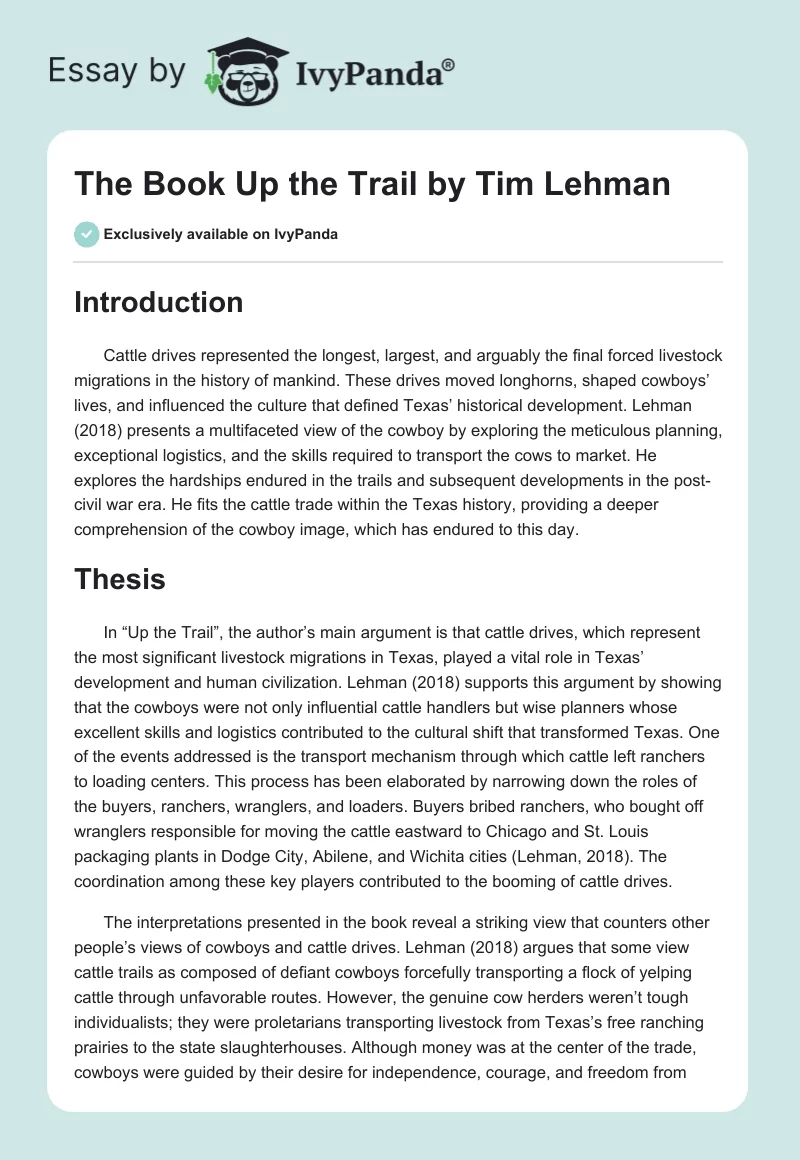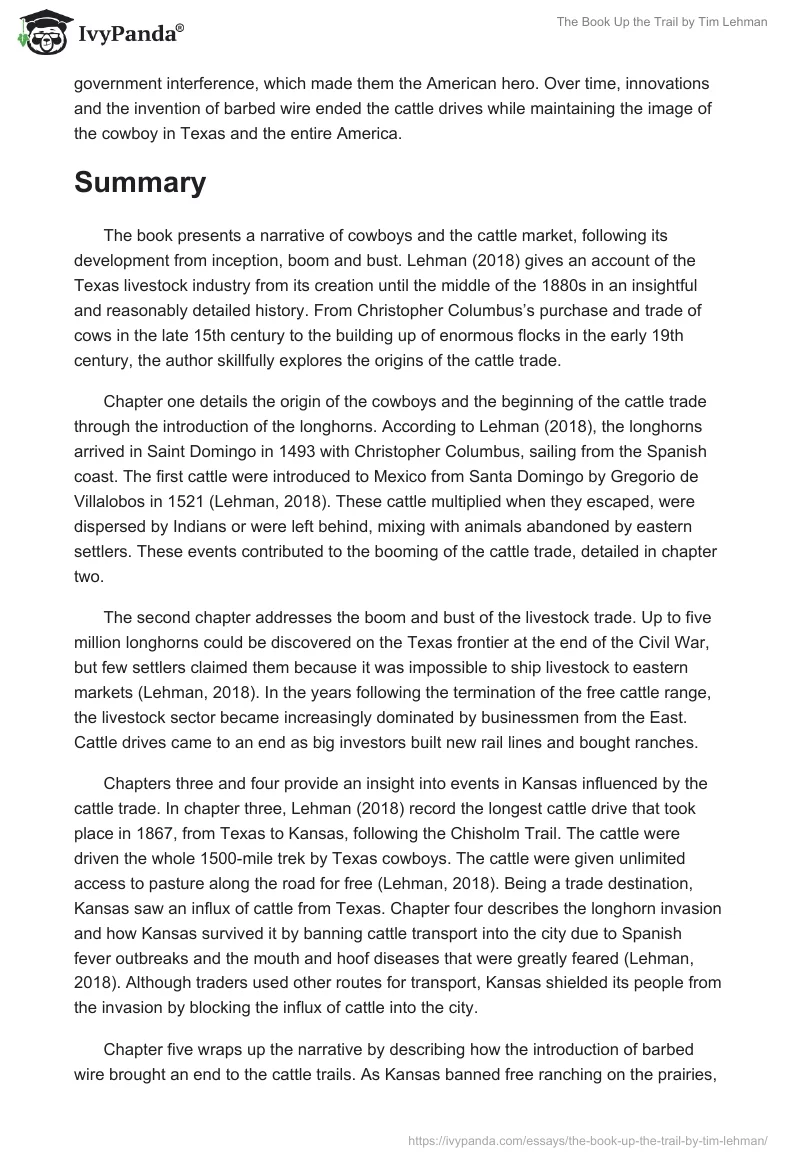Introduction
Cattle drives represented the longest, largest, and arguably the final forced livestock migrations in the history of mankind. These drives moved longhorns, shaped cowboys’ lives, and influenced the culture that defined Texas’ historical development. Lehman (2018) presents a multifaceted view of the cowboy by exploring the meticulous planning, exceptional logistics, and the skills required to transport the cows to market. He explores the hardships endured in the trails and subsequent developments in the post-civil war era. He fits the cattle trade within the Texas history, providing a deeper comprehension of the cowboy image, which has endured to this day.
Thesis
In “Up the Trail”, the author’s main argument is that cattle drives, which represent the most significant livestock migrations in Texas, played a vital role in Texas’ development and human civilization. Lehman (2018) supports this argument by showing that the cowboys were not only influential cattle handlers but wise planners whose excellent skills and logistics contributed to the cultural shift that transformed Texas. One of the events addressed is the transport mechanism through which cattle left ranchers to loading centers. This process has been elaborated by narrowing down the roles of the buyers, ranchers, wranglers, and loaders. Buyers bribed ranchers, who bought off wranglers responsible for moving the cattle eastward to Chicago and St. Louis packaging plants in Dodge City, Abilene, and Wichita cities (Lehman, 2018). The coordination among these key players contributed to the booming of cattle drives.
The interpretations presented in the book reveal a striking view that counters other people’s views of cowboys and cattle drives. Lehman (2018) argues that some view cattle trails as composed of defiant cowboys forcefully transporting a flock of yelping cattle through unfavorable routes. However, the genuine cow herders weren’t tough individualists; they were proletarians transporting livestock from Texas’s free ranching prairies to the state slaughterhouses. Although money was at the center of the trade, cowboys were guided by their desire for independence, courage, and freedom from government interference, which made them the American hero. Over time, innovations and the invention of barbed wire ended the cattle drives while maintaining the image of the cowboy in Texas and the entire America.
Summary
The book presents a narrative of cowboys and the cattle market, following its development from inception, boom and bust. Lehman (2018) gives an account of the Texas livestock industry from its creation until the middle of the 1880s in an insightful and reasonably detailed history. From Christopher Columbus’s purchase and trade of cows in the late 15th century to the building up of enormous flocks in the early 19th century, the author skillfully explores the origins of the cattle trade.
Chapter one details the origin of the cowboys and the beginning of the cattle trade through the introduction of the longhorns. According to Lehman (2018), the longhorns arrived in Saint Domingo in 1493 with Christopher Columbus, sailing from the Spanish coast. The first cattle were introduced to Mexico from Santa Domingo by Gregorio de Villalobos in 1521 (Lehman, 2018). These cattle multiplied when they escaped, were dispersed by Indians or were left behind, mixing with animals abandoned by eastern settlers. These events contributed to the booming of the cattle trade, detailed in chapter two.
The second chapter addresses the boom and bust of the livestock trade. Up to five million longhorns could be discovered on the Texas frontier at the end of the Civil War, but few settlers claimed them because it was impossible to ship livestock to eastern markets (Lehman, 2018). In the years following the termination of the free cattle range, the livestock sector became increasingly dominated by businessmen from the East. Cattle drives came to an end as big investors built new rail lines and bought ranches.
Chapters three and four provide an insight into events in Kansas influenced by the cattle trade. In chapter three, Lehman (2018) record the longest cattle drive that took place in 1867, from Texas to Kansas, following the Chisholm Trail. The cattle were driven the whole 1500-mile trek by Texas cowboys. The cattle were given unlimited access to pasture along the road for free (Lehman, 2018). Being a trade destination, Kansas saw an influx of cattle from Texas. Chapter four describes the longhorn invasion and how Kansas survived it by banning cattle transport into the city due to Spanish fever outbreaks and the mouth and hoof diseases that were greatly feared (Lehman, 2018). Although traders used other routes for transport, Kansas shielded its people from the invasion by blocking the influx of cattle into the city.
Chapter five wraps up the narrative by describing how the introduction of barbed wire brought an end to the cattle trails. As Kansas banned free ranching on the prairies, barbed wire was introduced to keep cattle ranchers from following the trails to the market (Lehman, 2018). Although the trade came to an end, cowboys’ legacy lived on as they ventured into other areas, including the famous horse-riding competition.
Historical Context
The book complements historical records of Texas’s economic and political developments. It adds to the knowledge gained through class lectures concerning the history of Texas, from mining and free-range cattle trades to an industrialized city with well-developed rail transport. Lehman (2018) gives an account of the development of the intercontinental railroad, which followed the cattle trails, highlighting its economic importance. The book’s five chapters add to the understanding of Texas by demonstrating how cowboys’ courage and skill during the cattle drives led to the fast development of efficient transport systems, leading to rapid industrialization.
Quality Analysis
The author presents a compelling case for the cowboys’ success through the cattle trade. The main strengths of the work are strong historical support and clear connections to the thesis. The only weakness pertains to the inadequate political inference regarding neighboring countries’ responses to the trade. Lehman (2018) demonstrates his arguments by narrating a tale from the perspective of a cowboy from west Texas who fights against the odds to succeed in a frontier region. The author supports his claim about the circumstances leading up to cowboys earning their term by citing relevant historical data concerning Native Americans and Spaniards who were also interacting around this time.
Conclusion
In this book, the author provides an elaborate narration of cattle drives and the cowboys’ experiences from the 15th century to the end of the trade in the 19th century. Through the five chapters, Lehman describes the origin of the cowboys and the trade and shows how it boomed and busted. He further explores the organization of the longest cattle trail and the subsequent longhorn invasion, and lastly, the end of the trails and the endurance of the cowboy image. The author carefully interlinks historical events providing credibility and value to his arguments.
Reference
Lehman, T. (2018). Up the trail. How Texas cowboys herded longhorns and became an American icon. Johns Hopkins University Press.


